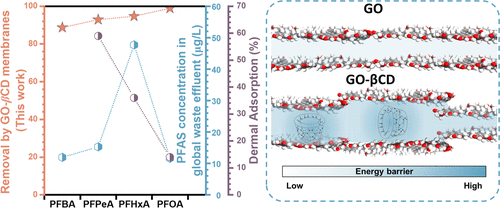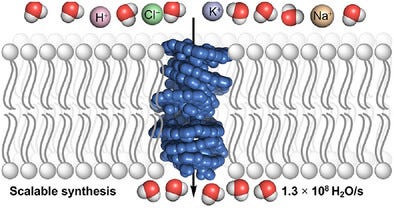#258 - Solar Electrolysis, Aquaporins, Light & Plasma and beta-cyclodextrin
Water Water Everywhere...
Hey Readers,
This week we have a bunch of pollutant stoppers of varying degrees of ability. Let’s get into it!
First off the most-written-about pollutant PFAS. Researchers at Monash University in Australia, have developed a water filtration membrane that effectively removes small PFAS molecules, overcoming a significant challenge faced by conventional water filters. The research team designed a beta-cyclodextrin (βCD) modified graphene oxide (GO-βCD) membrane with nanoscale channels that selectively retain PFAS while allowing water to pass through it.
What sets this solution apart is the fact that conventional polyamide membranes struggle to block smaller PFAS molecules. By contrast these new membranes block over 90% of the PFAS in a liquid solution compared to traditional polyamide membranes, which typically remove only about 35% of PFAS in water.
Light & Plasma to kill complex pollutants
Two teenagers have been named as the European Winners of The Earth Prize 2025, developing a groundbreaking water purification solution using light and plasma to combat pollutants and antibiotic resistance. 18-year-old Tomáš Čermák from Czechia and 19-year-old Anna Podmanická from Slovakia are combining their research on water purification through photocatalysis (Anna’s) and work using cold plasma to destroy pollutants and antibiotic-resistant bacteria (Tomáš’s), to create their new solution.
Plasma is already proven to be effective in water purification. Same with Photocatalysis, which both work to break down organic pollutants and effectively inactivate bacteria, viruses and other pathogens. Anna and Tomáš are the first to bring these two schools of research together into one product. Their prototypes are proving effective at purifying water on a small, household scale. With the help of the Earth Prize, the team is working to develop a much larger prototype, capable of filtering more water.
Nature tends to teach us a lot, and this week is no different. Researchers at the King's College, London, UK and the University of Fribourg, Switzerland have developed polymer water channels, that can draw salt out of water, inspired by the body's own water filtering system. First the biology lesson - Aquaporins are proteins that rapidly transport water across cell membranes while excluding salt. They are critical for maintaining the right balance of water inside and outside cells and for concentrating or diluting urine in the kidneys.
The team developed artificial channels using long molecules of plastic, organized into a helix structure called polymers, or into cyclic structures called macrocycles. The channels were then tested inside vesicles, sacs of water contained in a greasy layer, similar to cells, which were then placed in a sugary solution. Water moves out of vesicles naturally by osmosis, even without water channels, but this process is slow. But when the artificial channels were added to the vesicles, water movement increased in speed and volume. Additionally they saw that salts didn't cross into the vesicle. They are now working to maximize their artificial channels' efficiency so they can even beat natural aquaporins.
Potable water as a by-product?
Sometimes the most ingenious solutions are the ones no one went looking for. Case in point - this week’s announcement from a Cornell University-led collaboration. This research group has developed a low-cost method to produce carbon-free “green” hydrogen via solar-powered electrolysis of seawater. A happy byproduct of the process? Potable water. While some may be interested in their hydrogen production capability, (and can read more about it here and here), what caught our eye was the clean water piece.
They started with solving for the solar energy/output nexus - While most solar cells only convert about 30% of sunlight into electricity, the remaining energy is released as waste heat. The team’s device captures much of this waste heat and uses it to warm and evaporate seawater. They do this by incorporating a capillary wick, which holds a thin film of seawater in direct contact with the solar panel. This allows for efficient heating and evaporation, leaving the salt behind. The resulting clean water vapor is then condensed. From where a portion of it is fed into an electrolyzer, powered by the solar panel, to split the water molecules into clean hydrogen and oxygen. The rest can amazingly be used a clean water!
That is it for this Friday, until next week,
Peace!







